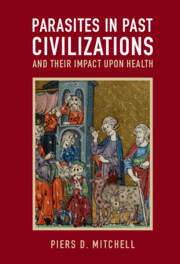Book contents
- Parasites in Past Civilizations and Their Impact upon Health
- Parasites in Past Civilizations and Their Impact upon Health
- Copyright page
- Contents
- Acknowledgements
- 1 Introduction
- 2 Near Eastern Civilizations
- 3 Ancient Egypt and Nubia
- 4 The Prehistoric Peoples of Europe
- 5 The Roman World
- 6 Medieval Europe
- 7 East Asian Civilizations
- 8 North American Indigenous Peoples
- 9 South and Central American Civilizations
- 10 Parasites, Migrations, and Epidemics
- 11 Conclusion
- Bibliography
- Index
8 - North American Indigenous Peoples
Published online by Cambridge University Press: 30 March 2023
- Parasites in Past Civilizations and Their Impact upon Health
- Parasites in Past Civilizations and Their Impact upon Health
- Copyright page
- Contents
- Acknowledgements
- 1 Introduction
- 2 Near Eastern Civilizations
- 3 Ancient Egypt and Nubia
- 4 The Prehistoric Peoples of Europe
- 5 The Roman World
- 6 Medieval Europe
- 7 East Asian Civilizations
- 8 North American Indigenous Peoples
- 9 South and Central American Civilizations
- 10 Parasites, Migrations, and Epidemics
- 11 Conclusion
- Bibliography
- Index
Summary
Early communities of the Arctic, subarctic, and north-west coast were most at risk of fish tapeworm infection, as these societies relied heavily on fish in their diet. In the north-eastern and south-eastern woodland regions early populations living around the Great Lakes would also have been at risk of fish tapeworm infection. Those communities living further south, especially those engaging in farming, were prone to parasites spread by poor sanitation including pinworm, roundworm, the protozoa Giardia sp. that causes dysentery, and possibly hookworm. Considering the early inhabitants of the great basin and arid south-west, populations were infected by pinworm at least by 7000 BCE, spread by close contact between group members in cave sites. Thorny-headed worm eggs may indicate the consumption of crickets as part of the early hunter-gatherer diet in these communities. With the introduction of agriculture we see an increase in the range of parasite species present, to include whipworm, roundworm, dwarf tapeworm, and taeniids. As population size and density increased, we find a progressive increase in pinworm (30–70% of coprolites in some communities) and head lice (44% of mummies).
Keywords
- Type
- Chapter
- Information
- Parasites in Past Civilizations and Their Impact upon Health , pp. 95 - 102Publisher: Cambridge University PressPrint publication year: 2023

